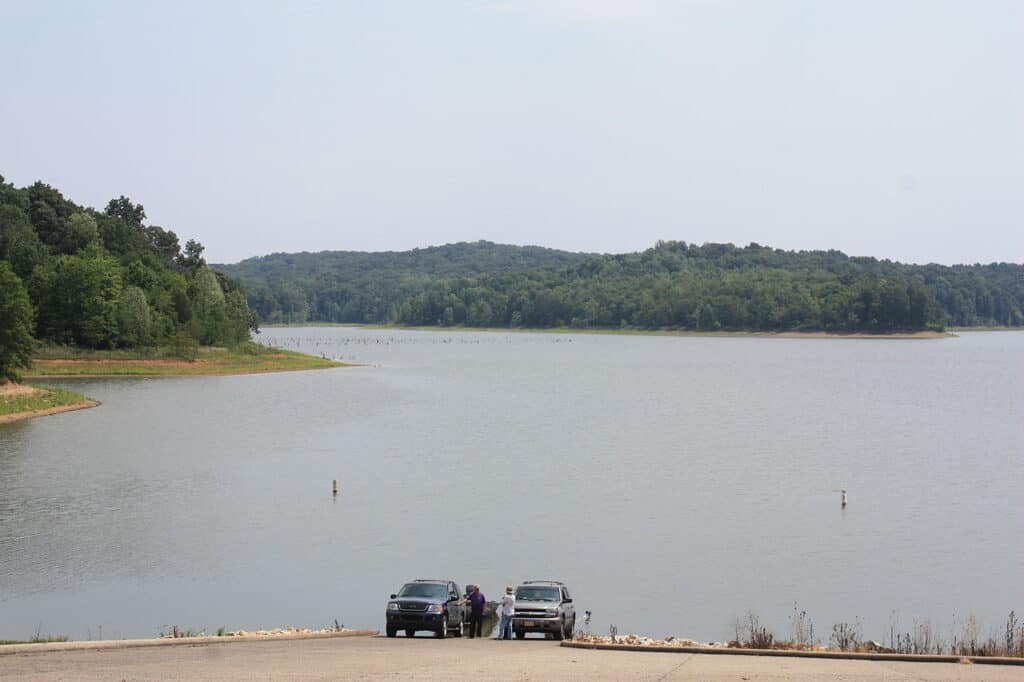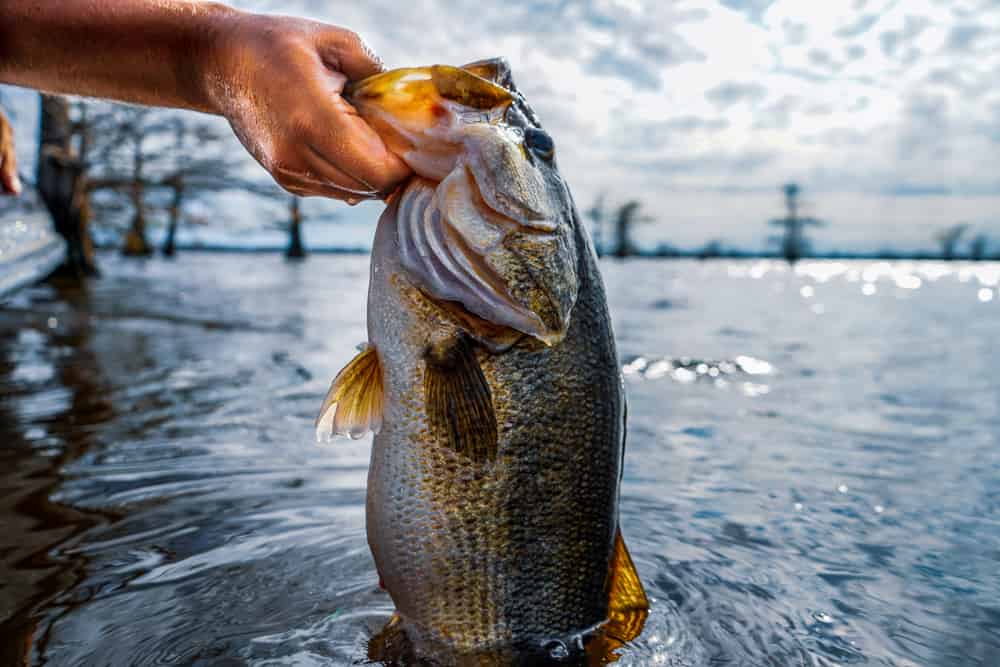Patoka Lake is a tranquil reservoir located in southern Indiana that offers an idyllic escape from the hustle and bustle of everyday life. This beautiful lake beckons adventurers with its vast waters, lush forests, and abundant wildlife. Whether you seek thrilling water sports or peaceful hikes along scenic trails, this place has something to delight everyone. In this article, we’ll take a look at everything you need to know about Patoka Lake!
Patoka Lake Location
Patoka Lake is located in southern Indiana, USA. Specifically, it is located in Crawford, Dubois, and Orange counties. It’s a popular destination for outdoor enthusiasts and nature lovers. The lake’s dam, constructed on the Patoka River, serves as a reservoir, providing water supply and flood control. With its diverse wildlife and scenic beauty, Patoka Lake attracts visitors year-round, making it a cherished spot for those seeking adventure and tranquility in the heart of nature.
Patoka Lake History
Initiated as a flood control and water supply project by the US Army Corps of Engineers, Patoka Lake has been around since the 1970s. The project’s goals included regulating the flow of the Patoka River to prevent flooding and secure a reliable water supply for the area.
Construction on the dam began in 1965 and was completed in 1978. The dam is an impressive structure, spanning 2,800 feet across the Patoka River. As it filled with water, the reservoir behind the dam began to take shape, forming Patoka Lake.
It was necessary to acquire hundreds of acres of land and relocate many communities to make room for the lake. It was a huge project that required intensive engineering work and coordination between many different organizations.
Over the years, the lake’s purpose evolved beyond flood control and water supply. Its scenic beauty and abundant recreational opportunities attracted tourists and outdoor enthusiasts. The lush forests and diverse wildlife around the lake provided a natural habitat for many species, making it an ideal destination for nature lovers and birdwatchers. The lake has been managed by the Indiana DNR since 1980, and the DNR is responsible for all conservation and recreational initiatives at the lake.
Patoka Lake Size
Patoka Lake has a surface area of 8,800 acres. The river it was created from, the Patoka River, runs about 118 miles. The earthen dam that was used to make the lake is approximately 145 feet high. Just as well, the nature preserves and parks that surround the lake total about 16,920 acres.

Patoka Lake is quite a large body of water that offers plenty of opportunities for different activities.
Depth of Patoka Lake
Patoka Lake is a fairly deep lake, though there are plenty of shallow areas near the shore that are not too deep or dangerous to swim in. The deepest parts of the lake measure about 52 feet deep.
Patoka Lake Water Level
The water level of Patoka Lake fluctuates quite a bit, based on seasonal variations and precipitation. As a reservoir formed by the Patoka River, it is subject to changes in rainfall and runoff. During periods of heavy rain, the lake’s water level rises, and during dry spells, it may decrease. Tourists and recreational enthusiasts should check the current water levels before planning activities like boating and fishing to ensure a safe and enjoyable experience.
Fishing in Patoka Lake
Patoka Lake fishing is just a lot of fun for fishermen of all skill levels. Fish of many kinds thrive in the lake because of their large size and rich habitats. Largemouth and smallmouth bass, bluegill, redear sunfish, black and white crappie, catfish, and sauger are some of the more common fish in Patoka Lake.
Largemouth bass is one of the most sought-after species in the lake. Known for their aggressive strikes and fighting spirit, they provide an exciting challenge for anglers. Smallmouth bass, though less abundant, are equally prized for their strength and acrobatic leaps.
Bluegill and redear sunfish are plentiful and easily caught, making them great options for beginners and families. Their pan-sized bodies and willingness to bite make for enjoyable fishing experiences, especially for children.
Crappie fishing is also popular at Patoka Lake. Black crappie and white crappie can be found in large populations, especially around underwater structures. Experienced fishermen often use live bait to target these tasty fish with great success.
Multiple species of catfish thrive in the lake’s waters. Night fishing for catfish is particularly popular, and these bottom-dwelling predators can grow to impressive sizes.
Sauger, a close relative of walleye, can be found in Patoka Lake as well. Although less common, they are highly prized for their firm, flavorful flesh.
To keep the lake’s environment thriving and fishing opportunities stable, the Indiana Department of Natural Resources carefully maintains the fish population through stocking programs and restrictions. To keep the lake’s fish population in check, fishermen should learn about the DNR’s fishing restrictions, such as size and bag limitations for each species.
Patoka Lake Geology
The geology of Patoka Lake plays a crucial role in shaping its landscape and supporting the diverse fish population. The lake is situated in southern Indiana, within the Crawford Upland region, which primarily consists of sedimentary rocks like limestone, shale, and sandstone. These rocks were formed over millions of years by ancient seas and rivers, contributing to the fertile soils and nutrient-rich waters that sustain various fish species.
The lake’s clear, clean waters provide an ideal habitat for a wide range of fish, including largemouth bass, smallmouth bass, bluegill, redear sunfish, black crappie, white crappie, catfish, and sauger. The rocky shoreline and submerged structures offer shelter and breeding grounds for these fish, enhancing their population and diversity.
Over time, the lake’s geology has created natural underwater structures such as ledges, drop-offs, and rock piles, which serve as feeding and resting areas for fish. These features attract anglers seeking prime fishing spots and add to the lake’s appeal as a recreational destination.
The geology of Patoka Lake also influences the water quality and temperature, contributing to the overall health of the fish population. The limestone in the surrounding region acts as a natural buffer, helping to regulate the lake’s pH levels and supporting a robust ecosystem.
Boating and Other Activities on Patoka Lake
Patoka Lake provides a haven for recreational enthusiasts with its wide array of activities. Boating takes center stage, offering an expansive waterway for exploration and relaxation. Visitors can sail, kayak, or cruise on motorboats, taking in the picturesque surroundings and enjoying the serenity of the water. Boating at Patoka Lake is an invigorating experience that allows people to connect with nature while indulging in water-based adventures.
Fishing at Patoka Lake
As mentioned earlier in this guide, fishing enthusiasts can find their slice of paradise at Patoka Lake. The lake’s diverse ecosystem and crystal-clear waters foster a rich variety of fish species. Anglers can try their luck catching largemouth bass, smallmouth bass, bluegill, redear sunfish, black crappie, white crappie, catfish, and sauger.

There’s no shortage of largemouth bass in Patoka Lake, making it a great spot for anglers to test out their skills.
©Maclane Parker/Shutterstock.com
Hiking and Birdwatching
Nature enthusiasts are drawn to Patoka Lake’s myriad of trails, inviting exploration and appreciation of the natural wonders surrounding the lake. Hikers can venture through lush forests and immerse themselves in the tranquil beauty of the wilderness. Birdwatchers find delight in spotting various avian species that call Patoka Lake home. The diverse birdlife, ranging from majestic eagles to vibrant songbirds, offers an enchanting experience for birdwatchers seeking to observe these creatures in their natural habitats.
Lakeside Picnics and Relaxation
Patoka Lake’s shoreline provides an ideal setting for lakeside picnics and leisurely relaxation. Families and friends can gather for a delightful day of outdoor dining while taking in the scenic beauty that surrounds them. The soothing sounds of the water and gentle breeze make for a refreshing and rejuvenating experience.
Hunting and Wildlife Photography
Designated areas around Patoka Lake offer opportunities for hunting and wildlife photography. Hunters can pursue game during the appropriate seasons while adhering to state regulations and guidelines. Wildlife photographers can capture the beauty and diversity of the area’s fauna. One can enjoy documenting moments that reflect the interconnectedness of nature’s balance at Patoka Lake with ease!
Preservation and Management
The DNR is essential to the protection and administration of Patoka Lake’s recreational opportunities. They take care of the lake’s environment and keep the fish population stable so that future generations can enjoy it for years to come.
Camping Near Patoka Lake
Camping close to Patoka Lake is a great way to spend time in nature and get away from the hustle and bustle of city life. Campsites in the area allow visitors to take in the stunning scenery of the lake’s environs.
Campground Amenities and Options
The campgrounds near Patoka Lake cater to a variety of camping preferences. From RV sites with electrical hookups to primitive tent-only sites, there’s an option for every camper. Many of the sites offer amenities such as fire rings, picnic tables, and access to restrooms and showers, enhancing the camping experience.
Reservations and Availability
During busy times, it’s best to reserve a camping area in advance to ensure you get one. Campsites may or may not be readily available, so it’s best to make arrangements in advance to avoid any last-minute scrambling.
Campfire Safety and Regulations
Campfires are an essential part of camping, providing warmth and ambiance. However, campers must adhere to fire safety regulations. Only designated fire rings are for campfires, and campers must never leave fires unattended. Additionally, it’s essential to check for any fire restrictions or burn bans that may be in place.
Leave No Trace
Respecting the natural environment is crucial while camping near Patoka Lake. Campers should follow the “Leave No Trace” principles, which include packing out all trash, minimizing the impact on the surroundings, and being considerate of wildlife and other campers.
Wildlife and Safety
The area around Patoka Lake is home to diverse wildlife. Campers should be respectful of the animals’ habitats and maintain a safe distance from them. Proper food storage is essential to avoid attracting wildlife to the campsite. It’s essential to familiarize oneself with the types of wildlife in the area and take necessary precautions to ensure a safe camping experience.
Check-In and Check-Out Times
Campers should adhere to the campground’s check-in and check-out times to facilitate a smooth transition for all visitors. Arriving within the designated check-in hours ensures assistance from campground staff, if needed while checking out on time allows the next campers to settle in promptly.
With just a little bit of knowledge about Patoka Lake, you’ll have an amazing and nature-filled trip!
Thank you for reading! Have some feedback for us? Contact the AZ Animals editorial team.








